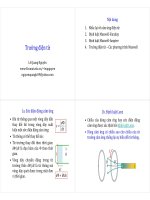Section 4 1 TRƯỜNG ĐIỆN TỪ
Bạn đang xem bản rút gọn của tài liệu. Xem và tải ngay bản đầy đủ của tài liệu tại đây (77.22 KB, 12 trang )
Slide Presentations for ECE 329,
Introduction to Electromagnetic Fields,
to supplement “Elements of Engineering
Electromagnetics, Sixth Edition”
by
Nannapaneni Narayana Rao
Edward C. Jordan Professor of Electrical and Computer Engineering
University of Illinois at Urbana-Champaign, Urbana, Illinois, USA
Distinguished Amrita Professor of Engineering
Amrita Vishwa Vidyapeetham, Coimbatore, Tamil Nadu, India
4.1
Conductors
and Semiconductors
4.1-3
Material Media can be classified as
(1) Conductors
and Semiconductors
electric property
(2) Dielectrics
(3) Magnetic materials – magnetic property
Conductors and Semiconductors
Conductors are based upon the property of
conduction, the phenomenon of drift of free
electrons in the material with an average drift
velocity proportional to the applied electric field.
4.1-4
electron
cloud
free electrons
+ bound
elecrons
nucleus
In semiconductors, conduction occurs not only by
electrons but also by holes – vacancies created by
detachment of electrons due to breaking of
covalent bonds with other atoms.
The conduction current density is given by
J c E
Ohm’s Law
at a point
4.1-5
conductivity (S/m)
e Ne e
h N h e e N e e
conductors
semiconductor
s
Mobility
Nh,e = Density of holes (h) or electrons (e)
4.1-6
Ohm’s Law
V El
V
Jc = E =
l
A
I Jc A
V
l
l
V I
A
V IR Ohm’s Law
l
R=
A
A
l
E, Jc
I
V
4.1-7
D4.1
I
0.1
Jc
10 3 A m 2
A 10 –4
(a) For cu,
5.8 10 7 S m
Jc
10 3
E
17.24 V m
7
5.8 10
(b)
h e Ne e
1700 3600 10 4 2.5 1013 106
1.602 10 19
2.1229 S m
Jc
103
E
471.1 V m
2.1227
4.1-8
(c)
l
FromR
1
A
l
1
10 6
Sm
–6
RA 10
Jc
10 3
E 6
3.14 mV m
10
4.1-9
Conductor in a static electric field
E
E
4.1-10
–
–
–
–
– S = –0E0
E0az
z=d
S0
z=d
z=0
z=0
+
+
+
+
+ S = 0 E 0
–
–
–
–
– S = –0E0
z=d
+
+
+
+
+
S = 0E0
z=0
–
–
–
–
–
S = –0E0
+
+
+
+
+ S = 0E0
E =0
+
+
+
+
+
–
–
–
–
–
E=–
–S0
S0
–
a z E0 a z 0
0
S0 0 E0
S0
0 a z
4.1-11
P4.3
(a) S0 S1 S2
Ei = 0
S1
z
S2
S1
S2
Ei –
az
a z 0
2 0
2 0
1
S1 S2 S0
2
4.1-12
(b)
E i1 = 0
S11
S12
Ei2 = 0
S21
S22
S11 S12 S1
S21 S22 S2
Write two more equations and solve for the four
unknowns.









